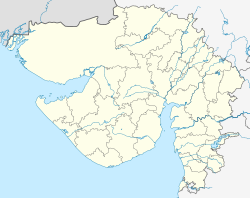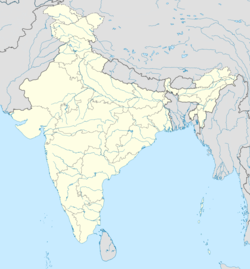History
Champaner was founded by Vanraj Chavda, the most prominent king of the Chavda Dynasty, in the 8th century. He named it after his friend and general Champa, also known later as Champaraj. By the later 15th century, the Khichi Chauhan Rajputs held Pavagadh fort above the town of Champaner. The young Sultan of Gujarat, Mahmud Begada, deciding to attack Champaner, started towards it with his army on 4 December 1482. After defeating the Champaner army, Mahmud captured the town and besieged Pavagadh, the well-known hill-fortress, above Champaner, where king Jayasimha had taken refuge. He captured the Pavagadh fort on 21 November 1484, after a siege of 20 months. [3] He then spent 23 years rebuilding and embellishing Champaner, which he renamed Muhammadabad, [4] after which he moved the capital there from Ahmedabad. Sultan Begada also built a magnificent Jama Masjid in Champaner, which ranks amongst the finest architectural edifices in Gujarat. It is an imposing structure on a high plinth, with a central dome, two minarets 30 meters in height, 172 pillars, seven mihrabs, and carved entrance gates with fine latticed windows called "jalis".
In 1535, after chasing away Bahadur Shah, Humayun led 300 Mughals to scale the fort on spikes driven into rock and stonework in a remote and unguarded part of the citadel built over a precipitous hillside on Pavagadh Hill. Large heaps of gold, silver and jewels were the war bounty even though Bahadur Shah had managed to escape with a lot to Diu [5]
Champaner is today the site of the Champaner-Pavagadh Archaeological Park, which UNESCO designated a World Heritage Site in 2004.

The Historic City of Ahmadabad or Old Ahmedabad, the walled city of Ahmedabad in India, was founded by Ahmad Shah I of the Gujarat Sultanate in 1411. It remained the capital of the state of Gujarat for six centuries and later became the important political and commercial centre of Gujarat. Today, despite having become crowded and dilapidated, it still serves as the symbolic heart of metropolitan Ahmedabad. It was inscribed as the World Heritage City by UNESCO in July 2017.

Panchmahal, also rendered as Panch Mahal, is a district in the eastern portion of Gujarat State western India. Panch-mahal means "five tehsils/talukas", and refers to the five sub-divisions that were transferred by the Maharaja Jivajirao Scindia of Gwalior State to the British: Godhra, Dahod, Halol, Kalol and Jhalod, Devgadh Baria. The district had a population of 2,390,776 of which 12.51% were urban as of 2001.

Qutb-ud-Din Bahadur Shah, born Bahadur Khan was a sultan of the Muzaffarid dynasty who reigned over the Gujarat Sultanate, a late medieval kingdom in India from 1526 to 1535 and again from 1536 to 1537. He ascended to the throne after competing with his brothers. He expanded his kingdom and made expeditions to help neighbouring kingdoms. In 1532, Gujarat came under attack of the Mughal Emperor Humayun and fell. Bahadur Shah regained the kingdom in 1536 but he was killed by the Portuguese on board a ship when making a deal with them.
Mahmud Begada or Mahmud Shah I was a Sultan of the Gujarat Sultanate. Raised to the throne at a young age, he successfully captured Pavagadh and Junagadh forts in battles which gave him his name Begada. He established Champaner as the capital.

Indo-Islamic architecture is the architecture of the Indian subcontinent produced by and for Islamic patrons and purposes. Despite an initial Arab presence in Sindh, the development of Indo-Islamic architecture began in earnest with the establishment of Delhi as the capital of the Ghurid dynasty in 1193. Succeeding the Ghurids was the Delhi Sultanate, a series of Central Asian dynasties that consolidated much of North, East, and Central India, and later by the Mughal Empire during the early 16th century. Both of these dynasties introduced Islamic architecture and art styles from West Asia into the Indian subcontinent.

Champaner-Pavagadh Archaeological Park, a UNESCO World Heritage Site, is located in Panchmahal district in Gujarat, India. It is located around the historical city of Champaner, a city which was founded by Vanraj Chavda, the most prominent king of the Chavda Dynasty, in the eighth century. He named it after the name of his friend and general Champa, also known later as Champaraj. The heritage site is studded with forts with bastions starting from the hills of Pavagadh, and extending into the city of Champaner. The park's landscape includes archaeological, historic and living cultural heritage monuments such as chalcolithic sites, a hill fortress of an early Hindu capital, and remains of the 16th-century capital of the state of Gujarat. There are palaces, entrance gates and arches, mosques, tombs and temples, residential complexes, agricultural structures and water installations such as stepwells and tanks, dating from the eighth to the 14th centuries. The Kalika Mata Temple, located on top of the 800 metres (2,600 ft) high Pavagadh Hill, is an important Hindu shrine in the region, attracting large numbers of pilgrims throughout the year.
Ahmedabad is the largest city in the state of Gujarat. It is located in western India on the banks of the River Sabarmati. The city served as political as well as economical capital of the region since its establishment. The earliest settlement can be recorded around the 12th century under Chaulukya dynasty rule. The present city was founded on 26 February 1411 and announced as the capital on 4 March 1411 by Ahmed Shah I of Gujarat Sultanate as a new capital. Under the rule of sultanate (1411–1511) the city prospered followed by decline (1511–1572) when the capital was transferred to Champaner. For next 135 years (1572–1707), the city renewed greatness under the early rulers of Mughal Empire. The city suffered due to political instability (1707–1817) under late Mughal rulers followed by joint rule between Maratha and Mughal. The city further suffered following joint Maratha rule. The city again progressed when politically stabilized when British East India Company established the rule in the city (1818–1857). The city further renewed growth when it gain political freedom by establishment of municipality and opening of railway under British crown rule (1857–1947). Following arrival of Mahatma Gandhi in 1915, the city became centre stage of Indian independence movement. Many activists like Sardar Patel served the municipality of the city before taking part in the movement. After independence, the city was a part of Bombay state. When Gujarat was carved out in 1960, it again became the capital of the state until establishment of Gandhinagar in 1965. Ahmedabad is also the cultural and economical centre of Gujarat and the seventh largest city of India.
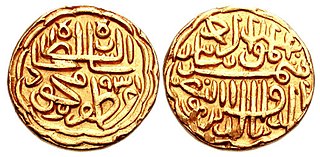
Shams-ud-Din Muzaffar Shah II or Muzafar II, born Khalil Khan, was a Sultan of the Muzaffarid dynasty, who reigned over the Gujarat Sultanate from 1511 to 1526. He was the eldest son of Sultan Mahmud Begada.
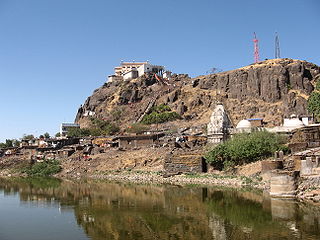
Pavagadh is a municipal operated region in Panchmahal district about 46 kilometres (29 mi) away from Vadodara in Gujarat state in western India. It is known for a famous Mahakali temple which is one of the 51 Shaktipeeths and draws thousands of pilgrims every day. However, as per records, this was originally a Jain temple belonging to the Svetambara Achalgaccha sect, whose Adhistayika Mahakali's idol was installed here in the 12th century. This locality Champaner-Pavagadh Archaeological Park was declared by UNESCO as a World Heritage Site in 2004.

The Gujarat Sultanate or Sultanate of Guzerat was a late medieval Islamic Indian kingdom in Western India, primarily in the present-day state of Gujarat. The kingdom was established in 1394 when Muzaffar Shah I, the Governor of Gujarat, declared independence from the Tughlaq dynasty of Delhi.
The Farooqi dynasty or the Farooq Shahi was the ruling dynasty of the Khandesh Sultanate from its inception in 1382 till its annexation by the Mughal emperor Akbar in 1601. The founder of the dynasty, Malik Ahmad participated in a rebellion against the Bahmani ruler Muhmmad Shah I in his early years. When he was compelled to flee from Deccan, he established in Thalner on the Tapti River. After receiving the grant of the fiefdoms of Thalner and Karanda from Firuz Shah Tughluq in 1370, he conquered the region around Thalner, which later became known as Khandesh. By 1382, he started ruling independently.
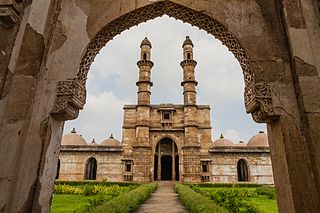
Jami Masjid in Champaner, Gujarat state, western India, is part of the Champaner-Pavagadh Archaeological Park, a UNESCO World Heritage Site, and is among the 114 monuments there which are listed by the Baroda Heritage Trust. It is located about 150 feet (46 m) east of the city walls (Jahdnpandh), near the east gate.
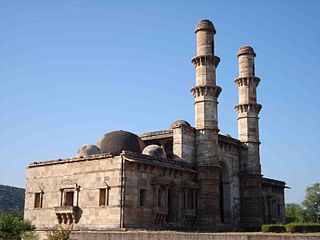
Kevada Mosque is a mosque in Champaner, Gujarat state, western India. It is part of the Champaner-Pavagadh Archaeological Park, a UNESCO World Heritage Site. The mosque has minarets, globe-like domes, and narrow stairs. According to Ruggles (2008), nature was integrated into the Kevada mosque's architecture in a way that was unusual elsewhere in the Islamic world.

Bawaman Mosque is a mosque in Champaner, western India. It is situated on the western side of one of the ancient city's fort gates, within the Champaner-Pavagadh Archaeological Park of Gujarat.

Nagina Mosque is a mosque in Champaner, Gujarat, India. It was built during the time of Mahmud Begada, in the 15th century, as were several other masjids, such as the Kevada, Bawaman, Ek Minar, Jama, Khajuri, and Shahar Ki. It has minarets, globe-like domes, and narrow stairs. It is part of the Champaner-Pavagadh Archaeological Park, a UNESCO World Heritage Site.

There are eleven different types of buildings at the UNESCO-protected Champaner-Pavagadh Archaeological Park in Gujarat, India, including mosques, temples, granaries, tombs, wells, walls, and terraces. The monuments are situated at the foot of and around the Pavagadh Hill. The Baroda Heritage Trust lists 114 monuments in the area, of which only 39 are maintained by the Archaeological Survey of India, due to limited funding. The Forest Department owns 94% of the land here, while the temple trusts and other sectarian establishments provide facilities for boarding and lodging to pilgrims and tourists. On the southern side near the foot of the hill some dilapidated houses and the foundations of Jain temples can also be seen.

Lila Gumbaj Ki Mosque in Champaner, Gujarat state, western India is one of the 114 monuments listed by the Baroda Heritage Trust that are part of the Champaner-Pavagadh Archaeological Park, a UNESCO World Heritage Site. It is located near the east gate of the former city.
Muizz-ud-Din Muhammad Shah II, born Karim Khan, was a ruler of the Muzaffarid dynasty, who reigned over the Gujarat Sultanate from 1442 to 1451. He expanded and strengthened the Sultanate.
The Architecture of Gujarat consists of architecture in the Indian state of Gujarat.

Jumma Masjid or Jama Masjid is a mosque in Uparkot Fort in Junagadh, Gujarat, India. The mosque was built in 15th century by converting a temple or a palace identified as Ranakdevi Mahal by local people and ASI. There is a controversy surrounding the identification of the structure.
